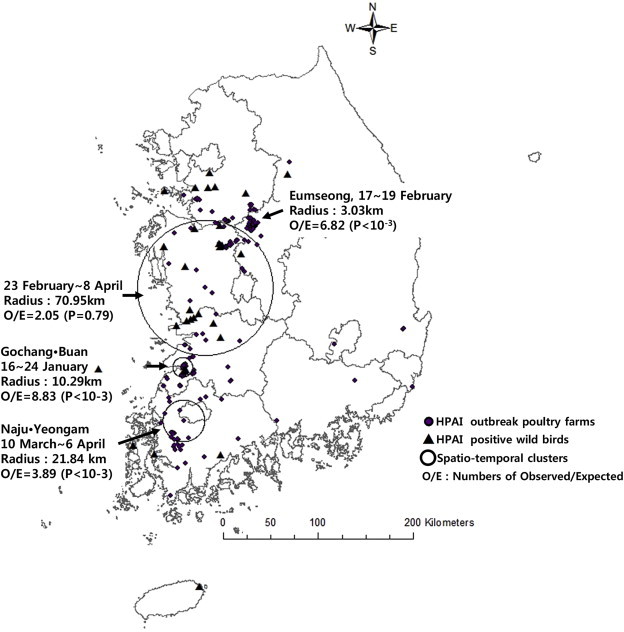Articles
- Page Path
- HOME > Osong Public Health Res Perspect > Volume 6(2); 2015 > Article
-
Original Article
H5N8 Highly Pathogenic Avian Influenza in the Republic of Korea: Epidemiology During the First Wave, from January Through July 2014 - Hachung Yoon, Oun-Kyong Moon, Wooseog Jeong, Jida Choi, Young-Myong Kang, Hyo-Young Ahn, Jee-Hye Kim, Dae-Sung Yoo, Young-Jin Kwon, Woo-Seok Chang, Myeong-Soo Kim, Do-Soon Kim, Yong-Sang Kim, Yi-Seok Joo
-
Osong Public Health and Research Perspectives 2015;6(2):106-111.
DOI: https://doi.org/10.1016/j.phrp.2015.01.005
Published online: February 19, 2015
Veterinary Epidemiology Division, Animal and Plant Quarantine Agency (QIA), Anyang, Korea
- ∗Corresponding author. heleney@korea.kr
• Received: November 30, 2014 • Revised: December 30, 2014 • Accepted: January 14, 2015
© 2015 Published by Elsevier B.V. on behalf of Korea Centers for Disease Control and Prevention.
This is an Open Access article distributed under the terms of the CC-BY-NC License (http://creativecommons.org/licenses/by-nc/3.0).
Figure & Data
References
Citations
Citations to this article as recorded by 

- The global prevalence of highly pathogenic avian influenza A (H5N8) infection in birds: A systematic review and meta-analysis
Xue-Yao Yang, Qing-Long Gong, Yan-Jin Li, Emad Beshir Ata, Man-Jie Hu, Yong-Yang Sun, Zhi-Yang Xue, Ying-Shi Yang, Xue-Pan Sun, Chun-Wei Shi, Gui-Lian Yang, Hai-Bin Huang, Yan-Long Jiang, Jian-Zhong Wang, Xin Cao, Nan Wang, Yan Zeng, Wen-Tao Yang, Chun-Fe
Microbial Pathogenesis.2023; 176: 106001. CrossRef - Impact of inland waters on highly pathogenic avian influenza outbreaks in neighboring poultry farms in South Korea
Saleem Ahmad, Kyeyoung Koh, Daesung Yoo, Gukhyun Suh, Jaeil Lee, Chang-Min Lee
Journal of Veterinary Science.2022;[Epub] CrossRef - Emergence of a Novel Reassortant H5N3 Avian Influenza Virus in Korean Mallard Ducks in 2018
Seon-Ju Yeo, Vui Thi Hoang, Tuan Bao Duong, Ngoc Minh Nguyen, Hien Thi Tuong, Mudsser Azam, Haan Woo Sung, Hyun Park
Intervirology.2022; 65(1): 1. CrossRef - Wild birds as reservoirs for diverse and abundant gamma- and deltacoronaviruses
Michelle Wille, Edward C Holmes
FEMS Microbiology Reviews.2020; 44(5): 631. CrossRef - Virus–virus interactions and host ecology are associated with RNA virome structure in wild birds
Michelle Wille, John‐Sebastian Eden, Mang Shi, Marcel Klaassen, Aeron C. Hurt, Edward C. Holmes
Molecular Ecology.2018; 27(24): 5263. CrossRef - Development of Clade-Specific and Broadly Reactive Live Attenuated Influenza Virus Vaccines against Rapidly Evolving H5 Subtype Viruses
Kobporn Boonnak, Yumiko Matsuoka, Weijia Wang, Amorsolo L. Suguitan, Zhongying Chen, Myeisha Paskel, Mariana Baz, Ian Moore, Hong Jin, Kanta Subbarao, Douglas S. Lyles
Journal of Virology.2017;[Epub] CrossRef - Multidimensional analysis model for highly pathogenic avian influenza using data cube and data mining techniques
Zhenshun Xu, Jonguk Lee, Daihee Park, Yongwha Chung
Biosystems Engineering.2017; 157: 109. CrossRef - Five distinct reassortants of H5N6 highly pathogenic avian influenza A viruses affected Japan during the winter of 2016–2017
Nobuhiro Takemae, Ryota Tsunekuni, Kirill Sharshov, Taichiro Tanikawa, Yuko Uchida, Hiroshi Ito, Kosuke Soda, Tatsufumi Usui, Ivan Sobolev, Alexander Shestopalov, Tsuyoshi Yamaguchi, Junki Mine, Toshihiro Ito, Takehiko Saito
Virology.2017; 512: 8. CrossRef - Complete analysis of the H5 hemagglutinin and N8 neuraminidase phylogenetic trees reveals that the H5N8 subtype has been produced by multiple reassortment events
Andrew R. Dalby
F1000Research.2016; 5: 2463. CrossRef - Phylogenetic and biological characterization of three K1203 (H5N8)-like avian influenza A virus reassortants in China in 2014
Juan Li, Min Gu, Dong Liu, Benqi Liu, Kaijun Jiang, Lei Zhong, Kaituo Liu, Wenqi Sun, Jiao Hu, Xiaoquan Wang, Shunlin Hu, Xiaowen Liu, Xiufan Liu
Archives of Virology.2016; 161(2): 289. CrossRef - Experimental infection of SPF and Korean native chickens with highly pathogenic avian influenza virus (H5N8)
Eun-Kyoung Lee, Byung-Min Song, Hyun-Mi Kang, Sang-Hee Woo, Gyeong-Beom Heo, Suk Chan Jung, Yong Ho Park, Youn-Jeong Lee, Jae-Hong Kim
Poultry Science.2016; 95(5): 1015. CrossRef - Wild waterfowl migration and domestic duck density shape the epidemiology of highly pathogenic H5N8 influenza in the Republic of Korea
Sarah C. Hill, Youn-Jeong Lee, Byung-Min Song, Hyun-Mi Kang, Eun-Kyoung Lee, Amanda Hanna, Marius Gilbert, Ian H. Brown, Oliver G. Pybus
Infection, Genetics and Evolution.2015; 34: 267. CrossRef - Intracontinental and intercontinental dissemination of Asian H5 highly pathogenic avian influenza virus (clade 2.3.4.4) in the winter of 2014–2015
Takehiko Saito, Taichiro Tanikawa, Yuko Uchida, Nobuhiro Takemae, Katsushi Kanehira, Ryota Tsunekuni
Reviews in Medical Virology.2015; 25(6): 388. CrossRef





 PubReader
PubReader Cite
Cite
